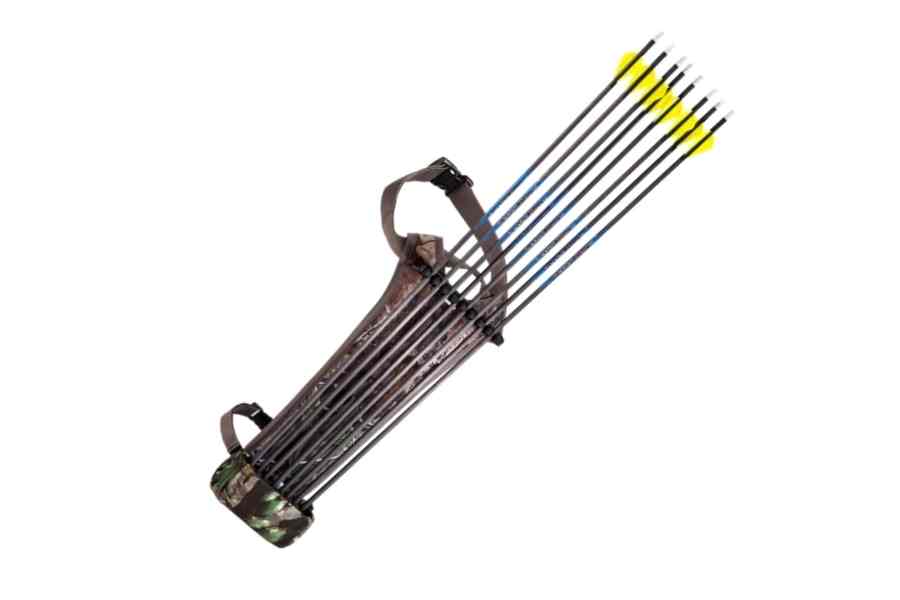Like a musician with their instrument, you, an archer, know the importance of every piece of your gear. Your quiver is not just a holder for your arrows – it’s a crucial part of your shooting performance.
You’ve probably encountered hip and field quivers in your quest for the perfect archery accessory.
But have you ever stopped to consider the differences or pondered which one might better serve your needs?
Key Differences
Angle
The Field Quiver is designed differently than a hip quiver. In a Field Quiver, the fletching of the arrows angles backward behind the shooter, while in a hip quiver, the fletching angles forward.
Size
Field quivers are more compact and streamlined than hip quivers. They have fewer and smaller storage compartments compared to hip quivers.
Streamlined
The backward angling of the arrows in a Field Quiver makes it less bulky and more aerodynamic than a traditional hip quiver with forward-facing arrows.
Navigation
The compact design and orientation of the Field Quiver is better suited for archers who need to move through dense brush or confined spaces, as it hugs the body more closely.
Let’s take a closer look at these two types of quivers, dissect their features and benefits, and help you make an informed decision that could change how you shoot.
Contents (Jump to Topic)
ToggleUnderstanding Hip Quivers
Diving into the world of archery, it’s crucial to understand the functionality and benefits of hip quivers.
read… compound bow quivers
This popular accessory attaches to your waist belt, positioning your arrows with the nock end pointing forward for easy access and selection.
Hip quivers and field quivers, while similar, serve different purposes. When it comes to understanding hip quivers, consider its design and use.
A hip quiver is made from various materials, offering robustness and durability.
It’s fully ambidextrous, meaning it’s suitable for both left and right-handed archers.
The quiver belt ensures the quiver stays in place while in action, allowing you to concentrate on your target.
One significant advantage of hip quivers is the convenience they offer.
Arrows within arm’s reach allow quick selection, especially in a competitive setting.
This feature, coupled with the additional storage space for archery accessories, makes the hip quiver a preferred choice for many archers.
read.. the different types of bow quivers
Field Quivers Explained
Shifting your focus to field quivers, you’ll find that, unlike hip quivers, these are designed with a sleeker profile and arrows pointing behind your arm. This feature makes them a popular choice among competitive archers and professionals.
Between quivers and field quivers, the latter provides a streamlined design that reduces the risk of catching on objects, enhancing your mobility during shooting sessions.
A field quiver is built with functionality and convenience in mind.
Haul-it-all field quiver features, including a modular design and a PALS grid for accessories, balance its compact size.
These elements make it versatile and adaptable to various shooting needs.
The field quiver’s ambidextrous usage ensures that it can accommodate your requirements no matter your preferred hand for shooting.
Moreover, the field quiver features a spacious section for arrow storage.
Despite its sleek form, it doesn’t compromise on space. The design allows for easy arrow retrieval, promoting efficiency during shooting.
Pros and Cons: Hip Quivers
While field quivers offer a streamlined design ideal for competitive archery, hip quivers’ advantages and potential drawbacks are worth exploring.
Hip quivers attach directly to your belt loop, providing easy access and visibility of your arrows for quick selection during shooting.
This is particularly beneficial for pro shooters who need to make rapid decisions in the heat of competition.
They also offer ample space for storing arrows and accessories, enabling you to carry all your gear conveniently.
Another advantage of hip quivers is they allow you to count arrow shots for end requirements, aiding in better performance tracking.
However, hip quivers also have cons. One potential drawback is that they can be cumbersome and may catch on objects or other archers, especially in limited space.
This can be problematic in crowded shooting ranges or during fast-paced competitions.
Additionally, you might find that cheaper models of hip quivers may flap awkwardly and cause discomfort during use.
Pros and Cons: Field Quivers
In contrast to hip quivers, field quivers offer a sleeker profile and improved arrow direction, making them a favored choice among competitive archers and professionals.
Field quivers have the pro of keeping your arrows within your space and away from your target mates.
They’re particularly advantageous in target and 3D archery, where precision and streamlined movement are key.
However, there are also cons to field quivers.
While they offer a sleek, professional look, they don’t provide as much storage space as hip quivers.
This can be a drawback if you’re an archer who needs to carry many arrows or additional accessories.
Another potential downside is that they require more spatial awareness.
You’ll need to look back into your quiver to select an arrow, unlike with a hip quiver, where you can easily see and select your arrow.
Conclusion
Considering the pros and cons of both hip and field quivers, it’s clear that your choice will ultimately depend on your personal needs as an archer.
If quick and easy access to your arrows is your priority, a hip quiver might be your ideal choice.
These heavy-duty quivers offer a spacious three-stage arrow bay, allowing organized storage for your arrows.
Additionally, their forward-pointing position provides excellent visibility and selection.
Sources:
https://eastonarchery.com/2021/06/hip-quivers-and-field-quivers-whats-the-difference/
https://elevationequipped.com/product-category/target/quivers/
https://kifaru.net/products/field-quiver
https://bowhunterssuperstore.com/bow-accessories/quivers/hip-quivers/
https://www.3riversarchery.com/buy/shooting-gear/quivers/pocket-hip-quivers








